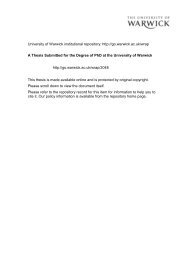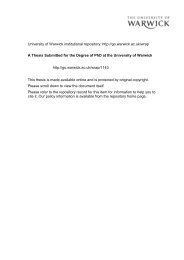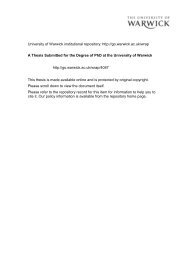From Page to Screen - WRAP: Warwick Research Archive Portal ...
From Page to Screen - WRAP: Warwick Research Archive Portal ...
From Page to Screen - WRAP: Warwick Research Archive Portal ...
Create successful ePaper yourself
Turn your PDF publications into a flip-book with our unique Google optimized e-Paper software.
There is still the question how objective or subjective the results of the reading process<br />
can be and if there is any right or wrong in concretising a text. Roman Ingarden<br />
presumes in VomErkennendesLiterarischenKunstwerks that the literary work is an "organic<br />
whole", that the text has indeterminacies and that a reader has <strong>to</strong> concretise them<br />
correctly: "Die Funktion des Lesers besteht darin, sich den vom Werk ausgehenden<br />
Direktiven und Suggestionen zu fiigen {...J."73<br />
That, of course, limits the activity of the reader enormously and puts him back in<strong>to</strong> the<br />
passive role of somebody who can only react <strong>to</strong> given orders. ] auss and Iser are more<br />
open-minded, according <strong>to</strong> them different readers are allowed <strong>to</strong> fill the gaps in<br />
different ways. A reading is neither purely subjective or arbitrary, nor is there only one<br />
pre-given correct interpretation, the text<br />
"gewahrt einen Spielraum von Akrualisierungsmoglichkeiten, denn er ist zu<br />
verschiedenen Zeiten von unterschiedlichen Lesern immer ein wenig anders<br />
verstanden worden. "74<br />
and an "Auslegungsspielraum" exists <strong>to</strong> fill the gaps between the different "schematized<br />
views". It is a process of balance between certain means and signals an author gives and<br />
shared literary conventionvs. readers' private inputs.<br />
The text encodes within itself an "implied reader" (implizierten Leser) who shares the<br />
code and the cultural background of the author <strong>to</strong> a certain extent. While writing the<br />
text the author has one potential audience more than another in mind and as long as<br />
there is a certain correspondence of the code implied by the author and the one ofthe<br />
actual reader and as long as the reading ofa text is more or less coherent, it is acceptable<br />
for Iser.<br />
The problem with this notion is that it is based on the assumption that a literary work<br />
can or should be something "coherent" or "an organic whole", which especially does not<br />
work with (postlmodern (hyperrtexts that often enough do not want <strong>to</strong> have ONE<br />
graspable meaning. They tantalise the reader with double-meanings or tty <strong>to</strong> have no<br />
73 Roman Ingarden, "Konkretisation und Rekonstruktion", in: Warning, Rezeptionsiisthetik, p. 5I.<br />
74 Iser, "Appellstruktur", p. 230.<br />
Chapter 3 -page 121





